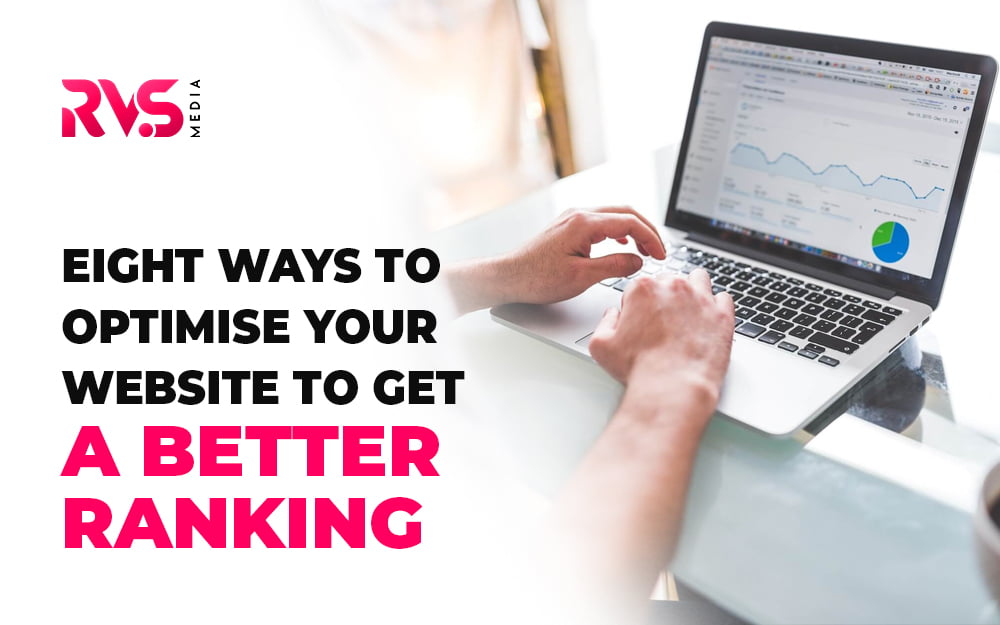Eight Ways To Optimise Your Website To Get A Better Ranking
- May 18, 2022
- By Tanisha Sharma

Estimated reading time: 7 minutes, 55 seconds
Getting that traffic you desire on your website can be a tough task. But not anymore, because we are here! This article is specially designed for you. Here, we are going to discuss how to optimise your website to increase your rankings on SERPs.
Why Website Optimisation Is So Important?
Website optimisation is the process of using advanced strategies, tools, and various experiments to achieve the objectives of your business. It helps in driving more traffic, growing revenue, and increasing conversions to your website.
Do you know that 68% of online experiences start with search engines? This is enough to make you understand the significance of web optimisation, isn’t it? By optimising your website, you don’t only attract more traffic to your site but also help in converting your visitors into customers. By performing targeted optimisation, you can design more personalised experiences to help the businesses achieve their goal.
8 Ways To Optimise Your Website To Rank Better
Without letting you wait for more, let’s just dive directly into understanding how you can optimise your website to rank higher on the SERPs. By implementing all these strategies we are pretty sure that you’ll be able to gain all the success that you have been wishing for.

1. Set your goals
A person without goals wanders. People generally have a habit of adopting SEO strategies without actually setting their goals. But, when you don’t have goals, how will you move in the right direction? That’s why, first things first, you need to be clear about what you want to achieve.
Some great key performance indicators or KPIs may be:
- The volume of traffic to your site.
- Position your website to appear on the SERP.
- The number of pages of your site being indexed by Google.
- The number of conversions/inquiries is driven by natural search. (Rather than paid search)
So, setting your goals should be your first and foremost priority.
2. Optimise Your Images
We, humans, are visual creatures and so are the search engines. Images and other pictures, and videos work great for your website. That’s why it’s very important to add images to your website. But, make sure to optimise them correctly, if you wish to improve your local SEO rankings.
By optimising we mean, making sure to upload the images in the proper size and format. Big pictures or images tend to slow the loading time of your page. And that may deteriorate your ranking!
So, before uploading, compress or resize your images. Also, you can make use of the images to fit the keywords by adding a description of the image.
For instance, suppose you have a site that deals in kitchen essentials. So, in place of naming a particular item as “Microwave”, you could name it as ” Best Microwave for kitchen”.
This way, you can use keywords in the title as well as the caption of your images.
3. Make Your Content Easily Readable
Readability matters a lot! Your content should not be too fancy and loaded with high-class words. Instead, it should be simple and easily readable.
For that, make sure to add all the necessary details in the correct format. Also, pay attention to the structure as well. These factors will surely make your content valuable to visitors.
You need to follow all the below-mentioned tips, to make your content readable to normal humans.
- Use paragraphs and short sentences.
- The length of a sentence should not be more than 20 words.
- Add header tags after a few hundred words.
- Add a table of contents for the long pages.
- Insert text callouts such as bolded phrases and blockquotes.
- Make use of supportive and descriptive imagery.
After following all these tips, you will see that your content is easily readable and scannable. Also, you will get to know that more and more visitors are interested in reading your content. Not only this, but they will also tap your CTAs.
4. Check The Loading Time Of Your Page
In the UK, only 48% users expect the websites to load within three seconds. That means, they want it to load faster than three seconds. In this busy world, no one even wants to waste a few seconds. That’s why the loading time of your page matters. But what’s the page load time?
It is the time taken by a webpage to show up on your screen. Several search engines and Google punish the websites that load like a tortoise. That means, they rank those websites only which can load easily and fastly.
This also applies to your visitors as well. If they get a bad experience from your website i.e., if the loading time of your webpage is slow, then they will instantly leave the website. And then, they go in search of websites that load faster. Hence, you lose your leads/sales. And you know what? They might never visit your website again after that!
But worry not! You can follow all these steps to improve the loading time of your page. They are:
- Minimise the size of the images/ pictures.
- Eliminate the unused Cascading Style Sheets or CSS.
- Minimise the HTTP requests.
- Host your site on a server that’s fast and quick.
- Optimise the browser caching.
If this all sounds so technical to you, then don’t worry! Your developers will do the same for you
5. Insert SEO Phrases and Keywords
Keywords are the key. Your content should have a proper amount of keywords stuffed into it. These keywords help you in ranking your website. They should be those words that a normal person uses to search.
We have listed down something we believe would be helpful to you.
- Make sure to include the primary keyword in the URL of your page.
- Include one main keyword and some other related keywords in the content.
- Try to use bullet points and subheadings wherever needed.
- Design diverse content using phrases and keywords.
- Also, make sure to include the main keyword in the title tag, meta description and also in your H1 or the main heading.
- Most importantly, insert images in the content. A good article contains an image after every 300 words.
6. Check Safety and Security
Security comes first! People might ask why safety and security are significant to optimise your website. Okay, suppose, you want to use a website and you know that website is not secure. Will you use it? You’ll not!
That’s the reason, no one wants to use a website that exposes them to various kinds of risks. So, if people don’t find your website trustworthy, then you can forget about some good backlinks!
To make sure your website is secured, use HTTPS encryption. This will offer you SSL certificates, providing a secure and trusted connection between your customer’s device and the portal. For accessibility, make sure that your website contains a sitemap and is well-coded. This will help the bots in knowing what your website is all about.
7. Create Long and High-Value Content
Creating high value and long-form content is also one factor that affects the ranking of your website. The ideal length of an article should be around 1600 words. This is just the minimum limit though.
Before deciding the most favourable length of your content, make sure to Google your primary keyword. After that, visit the first ten results in the search engines. Check how long the article is! Is it longer than 1600 words? If so, then you too should write it that way.
But understand, length is not the only that matters. Nevertheless, it indicates to Google that you are offering more detailed information. So, if a large number of visitors spend a long time on your page, by reading it to the end. Then, the chances are that you’ll rank higher.
8. Improve The Design and Layout Of Your Website
The first thing that people generally notice is the design and layout of your site. That’s why make sure to make the design of your website user friendly. This way, the visitors will spend more time on your website.
Do you know that 52.2% of website traffic comes only from mobile phones? Yes, you heard it right. The following are the ways by which you can make your website mobile-friendly.
- Bold the significant information to highlight it.
- Use a font size that is easy to read.
- Create bulleted or numbered lists.
It is very important to consider the design of your website while checking its mobility. Make sure that your visitors can read and access your site on mobile devices. So use UI/UX design that tends to increase your visitor experience. Learn more about the Importance of UI/UX design.
Also, there are various tools that you can use to test the mobility and mobile-friendliness of your website.
A good website design offers a good experience to the users. Also, it helps your website to rank higher in the search engine results.
Conclusion
Finally, we are at the end of this article and we believe that you got your answer to the question- ” How to optimise a website“.
This world is running on content. There’s so much content available on the internet and amidst all, making your website rank is a daunting task. Indeed, you can’t increase your rankings overnight. But gradually, with consistent efforts and following the best SEO practices, you can do so.
Moreover, you can follow all these above-mentioned tips to rank your website. Just in case, you need any help, then we at RVS Media leading eCommerce Web Development company is available for you. Call us and we’ll be happy to help you out.
 Shopify
Shopify




















